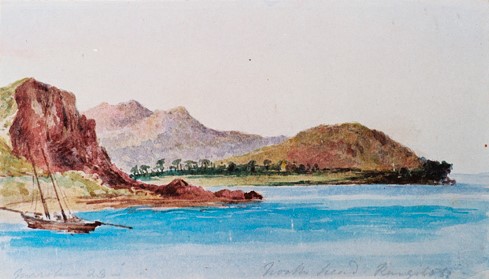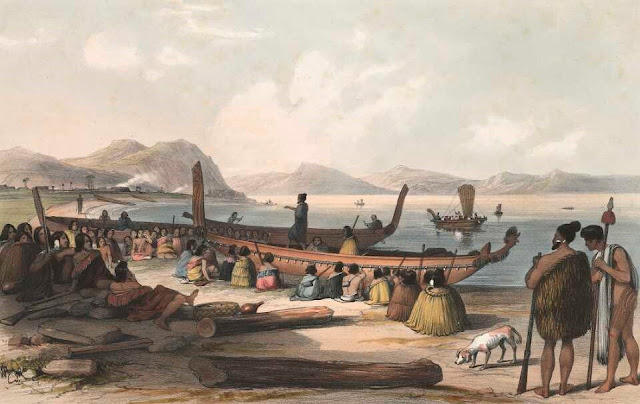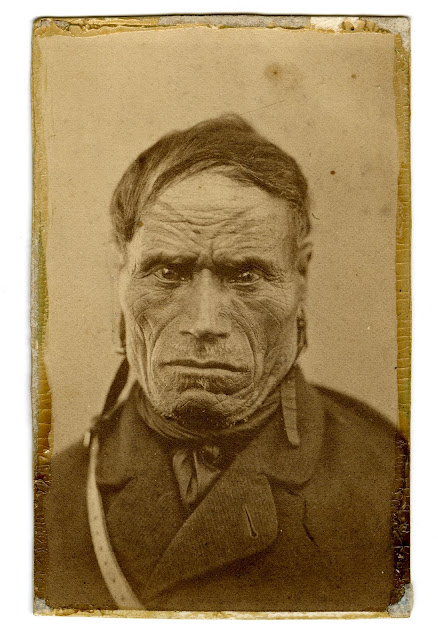Takapuna: A Name for Many Things
What is Takapuna? The te reo Māori proper noun has been adapted for use as a place name, a personal name, and many other things besides since its introduction in Aotearoa many centuries ago. Its origins are relatively clear, but how and when the word arrived in Aotearoa is disputed. Still, the name is unique. Nearly all instances of Takapuna worldwide can be traced back to the North Shore of Tāmaki Makaurau. This article gathers some of the better-known narratives regarding the history of the name, but it is not intended to be definitive—there are other traditions that are equally important to the story of Takapuna.
 |
| Image: Caroline Harriet Abraham. North Head and Rangitoto, ca 1853. Auckland Libraries Heritage Collections, 3-111-4. |
The story of Takapuna begins not with the name but rather a place. Tens of thousands of years ago, a volcano broke through fractured continental shelf to create a steep headland at the southern end of the North Shore. Millennia later, the legendary Polynesian navigator Kupe visited this place on his great voyage from Hawaiki to Aotearoa. He and his crew sheltered from a storm below the headland, which he named Te Hau Kapua, ‘cloud bank carried along by wind.’ According to some traditions, a small party from his crew remained behind to become the first settlers of Aotearoa.
 |
| Image: Sydney Parkinson. New Zealanders Fishing, 1770. British Library Add. 23920 f.44. |
Te Hau Kapua as the name for the headland did not last long. After Kupe’s visit, Toi Te Huatahi, the eponymous founder of the tangata whenua Te Tini o Toi, landed below the headland in search of a lost grandson. When he left, a group of his people remained behind under the leadership another grandson, Uika. Over time, the volcanic promontory at the north head of the Waitematā became known as Maunga-a-Uika (Uika’s Mountain), while Te Hau Kapua came to refer to the adjacent bay (today’s Torpedo Bay).
 |
| Image: Caroline Harriet Abraham. Looking east showing North Head and the opposite shore, 30 Mar 1853. Auckland Libraries Heritage Collections, 3-111-27. |
The name Takapuna arrived on the North Island shortly after, when the waka Tainui ran aground on a sandbar in Te Hau Kapua. The captain, Taikehu, swam ashore to ask for help from Te Tini o Toi watching from the foreshore. After the waka was refloated, Taikehu and his companions drank water from a nearby spring that flowed from the base of Maunga-a-Uika beside Cheltenham Beach. They named the spring Takapuna because it reminded them of a sacred spring they had left in Hawaiki. The word can be defined in many ways, but George Graham suggests ‘spring on the knoll.’
 |
| Image: Leslie Adkin. Vol Breccia (Takapuna Mount), south end, Cheltenham Beach, 1949. Te Papa Tongarewa A.008984. |
Over time, Takapuna came to replace Maunga-a-Uika as the name for North Head. A group from the waka Tainui remained behind to become the Manawaiti hapū of Ngāi Tai. They gradually settled along the east coast from the headland to beyond the Weiti River. They used Takapuna to refer to features that they found along the coast, including One Takapuna (Cheltenham Beach) and Mata Takapuna (Takapuna Head). In fact, Ngāi Tai Manawaiti’s influence spread as far as the Mahurangi River and the whole region was known as Te Takapuna—literally The Takapuna.
 |
| Image: Augustus Earl. War speech, previous to a naval expedition, 1838. Alexander Turnbull Library PUBL-0015-09. |
By the time of the Musket Wars in the 1820s, Ngāi Tai Manawaiti’s dominance over the North Shore had waned and other iwi controlled the peninsula. Richard Cruise was the first European to record a journey past Takapuna in 1820, at which time he noted ‘on the banks there were several natives, and some canoes.’ When Jules Dumont d’Urville visited in 1827—after Ngāpuhi had passed through the region—he was ‘disappointed in finding the area unpopulated.’ It would be nearly a decade before any substantial Māori group was re-established on the North Shore.
 |
| Image: J. M. Hacq. Excerpt from Carte particulière du Canal de l'Astrolabe Ile Ika-Na-Mawi, Nlle. Zélande, 1833. National Library of New Zealand. |
Dumont d’Urville was the first European to use ‘Taka Pouni’ to describe the coastline north of North Head. Later mapmakers followed his lead, adopting Takapuna or some variant such as Tagapoona or Takapona. Takapuna as a legal name first appeared on a title deed dated 18 November 1839 when Henry Taylor purchased all the land south of Wairau Creek from two Ngāti Paoa rangatira, Puhata and Te Awa. In 1842, Allan O’Neill surveyed the region, and the government designated the Parish of Takapuna as everything from North Head to Sunset Road.
 |
| Image: Unknown artist. Sketch from a poster for sale of land, looking east from Mount Victoria toward North Head, 8 December 1864. Auckland Libraries Heritage Collections, D_GVA_0003. |
Throughout the 1830s, small groups of Māori returned to the North Shore. The self-described last chief of Ngāi Tai Manawaiti, Hetaraka Takapuna, returned to Maunga-a-Uika around 1835 with around 300 people. His parents gave him the name ‘Takapuna’ as a reminder of his birthright. A remnant of his followers stayed until 1862, after which Hetaraka pressed his claims to much of the east coast of Tāmaki Makaurau in the Māori Land Court via two cases that lasted several years.
 |
| Image: Hartley Webster. Hetaraka [T]akapuna, ca 1860s. Alexander Turnbull Library PA2-1833. |
Hetaraka asserted his right to all the land from beyond the Tāmaki River to the Mahurangi River, as well as to the Gulf Islands. Through the course of two Māori Land Court cases, he stated that Governor William Hobson had promised to satisfy his claims in the 1840s. More controversially, he tried to prove that Ngāi Tai Manawaiti had remained in continuous possession of some of its ancestral lands in Tāmaki Makaurau even after Ngāti Whātua had laid claim to the region following the Musket Wars.
 |
| Image: G. W. Bishop. Hetaraka Takapuna, from New Zealand Chiefs, ca 1869. British Museum Oc,B1.5. |
Hetaraka’s arguments convinced many. In 1866, Ngāi Tai received some compensation after the Ōtata hearings, which focused on the islands. Hetaraka took a lead role in the Ōrākei case in 1868, which saw him defend his claims to the land between the Tāmaki River and Hobson Bay. Despite the earlier victory, the judge ruled on 29 December 1868 that Hetaraka ‘never had any title to or interest in this land...and that he has no more now.’ With his claims dismissed, the man named Takapuna disappeared from history. (For a detailed summary of the Ōrākei case, see the judge’s ruling in the Daily Southern Cross: Part 1 and Part 2.)
 |
| Image: Frederick Stack. View of Auckland New Zealand, from the lake on the North Shore, Plate 3. 1862. Hocken Pictorial Collections, University of Otago. |
With the Māori claims to the North Shore resolved, Pākehā settlement proceeded apace. The last recorded instance of Takapuna being associated with North Head occurred in 1864, after which developers chose not to use Māori words to describe geographical features in Devonport. Samuel Cochrane, though, saw in the term a marketing opportunity. In 1862, he renamed Pupuke Moana—more commonly The Lake—Lake Takapuna in a property advertisement. Early the next year, he borrowed the word again to promote two large property subdivisions around the lake, which he branded the ‘“Village of Takapuna”’ and ‘“Takapuna” Villa.’
 |
| Image: C. F. Bell. Anniversary Day on the Takapuna Racecourse, 29 January 1914. Auckland Libraries Heritage Collections, AWNS-19140205-42-4. |
The word also continued to serve a broader role across the lower North Shore. In 1876, the entirety of the area from Devonport to the Okura River and Lucas Creek was made into the Takapuna Ward of the County of Waitematā. Above Kaipātiki Creek, the Takapuna Public Cemetery was founded around 1881 (it later became the Birkenhead/Glenfield Cemetery). At Narrow Neck, the Takapuna Racecourse and Takapuna Jockey Club were formed in 1881, although the Takapuna Cup had been held since 1879. Next door on Takapuna Head, Fort Takapuna was established in late 1885 to combat potential Russian aggression.
 |
| Image: Sidney George Vaile. Ceremony outside Lake School, 1902. Auckland Libraries Heritage Collections T0432. |
Nevertheless, Takapuna increasingly came to refer exclusively to the settlement south of Lake Pupuke. The Takapuna Hotel was opened by Edward and Roger Barry on Barry’s Point in 1863. The Lake Takapuna Post Office was opened in 1880 with the word ‘Lake’ removed in 1882. In 1908, the word had become so widespread that Lake School was renamed Takapuna School.
 |
| Image: C. B. Turner. Borough of Takapuna, September 1924. Auckland Libraries Heritage Collections, Map 9326. |
A borough of Takapuna was first proposed by William J. Napier in 1894, but the population did not justify it until after the construction of the Takapuna Tramway in 1910. This caused a population boom, and a borough was duly established on 1 July 1913. This new administrative zone considerably reduced the definition of Takapuna to an area encompassing the land from Ngataringa Bay to Barry’s Point and Milford—2,770 acres in total. With the later additions of Castor Bay, Forrest Hill, and Sunnynook, the boundaries were set when Takapuna became a city on 22 July 1974.
 |
| Image: Unknown photographer. Group portrait of New Zealand Soldiers, Nurses and Medical Staff, 1919. Auckland Libraries Heritage Collections, T5244. |
On one occasion, the name Takapuna was also used elsewhere in New Zealand. During the Spanish Flu pandemic in November 1918, Hera Henare (née Subritzky), a Ngāti Hine wahine of Mōtatau marae in Northland and wife of the Northern Māori MP Taurekareka Henare, was nursing infirm soldiers at Fort Takapuna when she succumbed to the disease. Ngāti Hine considered her a wahine of great mana. She was brought back to Mōtatau and was interred above the Kawakawa river at a newly created wāhi tapu called Takapuna in recognition of the place of her death.
 |
| Image: Fr. Timothy Finigan. Takapuna House, John Fisher School, 26 January 2007. Flickr DSCF1794. |
The name was taken to England several times. When Allan O’Neill’s younger brother James moved back to Portsmouth in the mid-1870s, he adopted the name Takapuna for his Southsea home. In the 1910s, Arthur J. Bradstreet, whose brother was a draper in Takapuna, took the name for his London abode. Later, Herbert C. Hanchard, a former Devonport resident, followed the trend around 1920 with his cottage in Hastings. Indeed, Takapuna has been used for at least five other buildings throughout England including in Devon, Hull, East Lindsay, West Sussex, and Northumbria. Even an English racehorse went by the name, racing in Bath and surrounding towns in 1923 and 1924.
 |
| Image: David James Aldersley. Steamship ‘Takapuna’ at Wellington Harbour. Alexander Turnbull Library 1/1-002432-G. |
A total of three ships were named Takapuna. The first was a paddle steamer built for the Auckland & North Shore Steam Ferry Company that was launched in 1872. It shuttled people between Devonport and Queens Wharf for fifty years before being abandoned on Browns Island in 1922. In 1883, a two-mast schooner with the name entered service for the Union Steam Ship Company. It ferried passengers all over New Zealand before being scuttled in 1925. Meanwhile, Takapuna was the last boat built for the Takapuna Tramways & Ferry Company in 1924, and it continued to transport people until 1967.
 |
| Image: Unknown photographer. Dragon Boat racing off Takapuna Beach, 3 December 1988. Auckland Libraries Heritage Collections, T3401. |
Takapuna has become associated with many things since it was first used nearly seven centuries ago to describe a spring flowing out of a volcanic cave. Proclaimed wāhi tapu by Ngāi Tai Manawaiti, the sacred spring provided sustenance to Māori and Pākehā for generations. That ended suddenly and disrespectfully around 1900, when military engineers digging tunnels beneath Maunga-a-Uika North Head accidentally blocked the source. It has never flowed since and even its location is not known with absolute certainty. Today, the spring on the knoll no longer flows and its origins are all but forgotten, but its name nonetheless survives as a link between the modern-day North Shore suburb and the ancient Māori homeland of Hawaiki.
Author: Derek R. Whaley, Research North (Takapuna Library)
Selected references:
David Balderston, The Harbour Ferries of Auckland, Revised Edition (Wellington: Grantham House, 1991).
Department of Conservation, ‘Historic Fort Takapuna O Peretu’ (Auckland: Auckland Conservancy, 2001).
Jules-Sebastien-Cesar Dumont d’Urville, Voyage of the Corvette Astrolabe, Vol. 1 [reprint] (Paris: J. Tatsu, ca 1829).
George Graham, ‘Tainui,’ Journal of the Polynesian Society 60:1 (March 1951), 80-92.
‘An Historic Spring: Location of “Takapuna.” Origin of Suburb’s Name. Site Now Obliterated,’ New Zealand Herald, 8/09/1925, 11:5.
K. R. Howe, ‘Ideas about Māori origins,’ Te Ara – The Encyclopedia of New Zealand (accessed 10 May 2021).
Gainor Jackson, ‘Maori Occupation of the North Shore,’ Early History of the North Shore (Takapuna: North Shore Public Libraries, 1994).
Peter B. Maling, Historic Charts & Maps of New Zealand 1642–1875 (Birkenhead: Reed Publishing, 1996), 161.
‘Moa bones and adze head find may date to 1400s,’ NZ Herald 7 April 2010.
Ngāi Tai ki Tāmaki and the Trustees of the Ngāi Tai ki Tāmaki Trust and Crown: Deed of Settlement Schedule: Documents (Wellington: Office of Treaty Settlements, 2015).
Ngati Hine a Hineamaru, ‘The Great Flu Epidemic of 1918 in Ngati Hine communities’ (Facebook post, March 2016).
North Head: The Pre-European and Military History (Auckland: Department of Lands and Survey, 1978).
‘North Shore Heritage: Volume 2: North Shore Area Studies & Scheduled Items List’ (Auckland Council, 2011).
David Verran, ‘Maori and Pakeha on the North Shore, 1840-1926’ (Birkenhead: Birkenhead Heritage Society, 2007).
David Verran, The North Shore: An Illustrated History (Glenfield: Random House New Zealand, 2010).
Hi Derek, I managed to establish the location of the Takapuna Spring last year. It was at what is now 62 King Edward Parade. The recorded location in heritage databases has been corrected and the Auckland Council Heritage Unit is proposing to correct the Unitary Plan schedule entry and to change it to a Category A place. I’m no longer with AC but I’m sure you can obtain a copy of my evaluation which includes the evidence for its location. I didn’t have the opportunity to document the wider use of the name to the extent you have. Cheers Robert Brassey
ReplyDelete